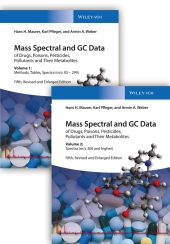 Neuerscheinungen 2016Stand: 2020-02-01 |
Schnellsuche
ISBN/Stichwort/Autor
|
Herderstraße 10
10625 Berlin
Tel.: 030 315 714 16
Fax 030 315 714 14
info@buchspektrum.de |

Hans H. Maurer, Karl Pfleger, Armin A. Weber
(Beteiligte)
Mass Spectral and GC Data of Drugs, Poisons, Pesticides, Pollutants, and Their Metabolites
Volume 1: Methods, Tables, Spectra (m/z 30 - 299) / Volume 2: Spectra (m/z 300 and higher)
5. Aufl. 2016. 1756 S. 276 mm
Verlag/Jahr: WILEY-VCH 2016
ISBN: 3-527-34287-7 (3527342877)
Neue ISBN: 978-3-527-34287-7 (9783527342877)
Preis und Lieferzeit: Bitte klicken
Das weltweit umfassendste Nachschlagewerk für klinische und forensische Toxikologen wurde erneut weitreichend aktualisiert. 2.000 Datensätze sind hinzugekommen. 10.430 Spektren potenziell schädlicher Substanzen werden jetzt aufgeführt, darunter 7.800 aus Metaboliten. In der Printversion enthalten die beiden Hardcover-Bände Listen vollständig referenzierter Massenspektren, in alphabetischer Reihenfolge oder geordnet nach ihrer Molekularmasse, mit Strukturformeln, der genauen Masse, GC-Retentionszeiten und weiteren experimentellen Daten, die für analytische Toxikologen von Relevanz sind. Zur besseren Identifizierung werden alle Substanzen nach entsprechenden toxikologischen Kategorien klassifiziert.
Band 1 enthält darüber hinaus einen Überblick über experimentelle Methoden sowie einen Namensindex der Verbindungen. Auch steht eine elektronische Datenbank, die mit allen wichtigen Massenspektrometern zum Einsatz kommen kann, zur Verfügung (weitere Einzelheiten unter www.wiley.com/go/databases).
The world?s most comprehensive reference for clinical and forensic toxicologists has once more been extensively updated: 2,000 data sets have been added for a total of 10,430 spectra of potentially harmful substances, including 7,800 from metabolites. In two hardbound volumes, the printed atlas contains a comprehensive listing of full reference mass spectra in order or molecular mass with the structural formula, exact mass, GC retention times and other experimental data that are relevant to the analytical toxicologist. To aid in compound identification, all substances are classified according to their toxicological categories.
In addition, volume 1 contains an overview on experimental methods, plus a compound index by name.
An electronic database for use with all major mass spectrometers is also available. For details, please visit www.wiley.com/go/databases.
VOLUME 1
INTRODUCTION
EXPERIMENTAL SECTION
Origin and choice of samples
Sample preparation
GC-MS apparatus
Determination of retention indices
Systematic toxicological analysis (STA) of several classes of drugs and their metabolites by GC-MS
Application of the electronic versions of this handbook using macros or AMDIS
Quantitative determination
CORRELATION BETWEEN STRUCTURE AND FRAGMENTATION
Principle of electron-ionization mass spectrometry (EI-MS)
Correlation between fundamental structures or side chains and fragment ions
FORMATION OF ARTIFACTS
Artifacts formed by oxidation during extraction with diethyl ether
Artifacts formed by thermolysis during GC (GC artifacts)
Artifacts formed during acid hydrolysis
TABLE OF ATOMIC MASSES
TABLE OF ABBREVIATIONS
REFERENCES
TABLES OF COMPOUNDS
MASS SPECTRA (m/z 30 - 299)
VOLUME 2
MASS SPECTRA (m/z 300 and higher)
I strongly recommend these two volumes for libraries and for all the GC-MS users carrying out environmental, toxicological, clinical, and pharmacological studies." (J Am Soc Mass Spectrom, 2011)


